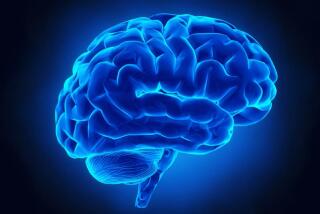Living With a Nightmare : New Research May Help Schizophrenics Control Illness That Attacks From Within
- Share via
One night nearly 25 years ago, the gentle, bird-like woman with the carefully modulated voice went berserk, rampaging through her office and smashing every window she could reach.
“I was scared to death,” Pat says. “When they took me through there the next day and showed me what I had done, I couldn’t believe that was me. I’d never been that angry before. I didn’t even know what I was angry at. I just wanted to destroy everything that was in front of me. But it wasn’t me. It was somebody else.”
It was the devil, Pat was certain. She had heard the demonic voice, clearly, commanding her to break the windows.
The episode left her terrified, exhausted, profoundly depressed and, at times, suicidal. Pat feared she could no longer control her mind, her emotions, her innermost thoughts.
Barely into her early 20s, and ridiculed by a father who could not understand his suddenly shattered daughter, Pat saw her life unravel.
She had become a victim of one of the most baffling, feared, unpredictable and misunderstood diseases, an amorphous malady that scientists and researchers are only now beginning to pin down: schizophrenia.
Afflicting an estimated 1% of the population , schizophrenia is a many-barbed crippler of the mind that attacks its victims with a frightening battery of dramatic symptoms.
It is widely misunderstood--often believed to be a strictly emotional affliction or a manifestation of split or multiple personalities.
But it is neither.
Latest research appears to indicate that schizophrenia is a biological--and genetic--brain disease, triggered by an imbalance of a chemical neurotransmitter. It manifests itself not as a split personality disorder, but as what Dr. Monte Buchsbaum, a psychiatry professor and director of UC Irvine’s pioneering Brain Imaging Center, calls “a heterogeneous group of illnesses.”
“The unusual parts of it,” Buchsbaum says, “are delusions--a strongly held belief in something that is typically impossible--and hallucinations: hearing voices, seeing things. These are really the two major hallmarks of schizophrenia.”
Within those two descriptions lies a nightmare world of bizarre thoughts and behaviors. A schizophrenic may believe he is being pursued by unseen tormentors, may not be able to express a cohesive thought, may not be able to pick out individual voices in a crowded room. He may become wildly agitated or catatonic or profoundly depressed, may clearly hear voices that are not there, may feel the touch of unseen hands, may cower from snakes he sees slithering through the air vents.
Explains Pat: “It felt to me like there was another being within me that had taken over and you’re fighting and struggling hard to get rid of this other person.”
The modest two-story house in Orange is unremarkable from the street, and subdued within. The furniture is inexpensive and functional. The atmosphere is far from institutional, but neither does it bear many individual marks. It is quiet, unadorned, a place to recover.
The home is one of four Orange County residences that are part of a pioneering outpatient program called HOMES (Helping Our Mentally Ill Experience Success), which began five years ago. At the facilities, small groups of mental patients live in a communal and unstructured environment, supervised only by visiting case workers. There is greater freedom and interdependency than in a board-and-care facility.
Pat lives here, along with Ellen--another schizophrenic--and two other women struggling back from debilitating mental illnesses. The atmosphere can become edgy and brittle, as if the occupants are always on guard against unseen and terrible trouble.
And they are. The women who suffer schizophrenia know the unwelcome boarder in their brains is there to stay, kept at bay only by an absolutely faithful routine of medication and avoidance of stress.
They speak in halting voices, and softly, as if afraid to disturb their tormentor. They sit rigidly in the presence of strangers, as if they might be preparing to flee.
And if one of their number has a relapse into psychotic behavior and must return for a time to the hospital--which recently happened--they are reminded that their disease never truly sleeps, that it could rise up to torment them again.
So they band together for support--kindred souls skirting the edge of hell.
Just 15 minutes away, in a world crisp and analytic, UCI scientists peer into diseased brains with high-tech machines that, for all their capabilities, still cannot completely explain schizophrenia’s raging core.
The terrifying sights and sounds were once thought to result from the patient’s early environment or upbringing. Scientists now believe individuals have no more control over the disease than they do eye color.
“It has a genetic basis that has been demonstrated both in twin studies and in studies of children who have been adopted,” Buchsbaum says. “It has some biological core that we’re trying to understand.”
That core probably lies in the brain’s deep recesses and is filled with a complex chemical that may hold the key to the disease: dopamine.
Dopamine, Buchsbaum says, is found in the brain’s central core areas called the basal ganglia, “which are involved with motor control, integration of visual, spatial and motor activity and the integration of emotional activity with visually guided motor activity.”
Scientists believe some abnormality in dopamine action causes schizophrenia.
But dopamine, which is manufactured in nerve cells and carries electrical signals across nerve synapses in the brain, is difficult to analyze from urine or blood samples, or even from samples of cerebral/spinal fluid, he says.
And the brain may be harmed if samples are taken directly from it, or if brain tissue biopsies are performed, he says.
Buchsbaum and a team of UCI researchers are among scientists nationally who are probing the brain from the outside, using brain-imaging techniques that can map areas of the brain and track down concentrations of, among other things, dopamine.
To track schizophrenia in the brain, the scientists use two separate techniques: Magnetic Resonance Imaging (MRI) and PET scans (Positive Emission Tomography). While the MRI scan provides an anatomical “map” of the brain and its parts, Buchsbaum says, the PET scan reveals how those parts work.
The promise of brain imaging, he says, lies in its ability to look at changes in specific regions of the brain: size and shape of the brain with MRI and the function of the brain with PET to find out which areas are abnormal and how drugs change them.
The researchers can literally see, in a cross-section picture of the brain, when dopamine is “turned on or turned off,” Buchsbaum says.
“We have found two major things different about the brain of a schizophrenic,” he says. “One is that there is low metabolism in an area of the brain called the frontal lobe, which is involved in planning and organization of behavior, mood regulation, impulsiveness and other aspects of personality. The second area that we found to be low is in the basal ganglia, the areas rich in dopamine. We’ve been trying to find out why those areas are low.”
Such mysteries remain, Buchsbaum says, because scientists are not dealing with a homogenous illness like an ear infection, but with “a heterogeneous group of illnesses, which is, I think, one of the principal barriers to understanding schizophrenia.”
“When we administer drugs, not everybody gets better.”
Ellen is proud of her artwork. She smiles as she shows off the color drawings, entries in a contest for Christmas-card artwork. But a few years ago she probably would not have been able to visualize the scenes of smiling people.
As it did for Pat, schizophrenia began in Ellen’s life in her early 20s. Unable to concentrate because of what she describes as “uncomfortable, nondescript” sensations, she could not hold a job and, for lack of rent money, moved out of apartments and onto the street.
The world around her began to be populated by weird apparitions: animals that talked to her, adults that appeared to her as children, children appearing as adults. To Ellen, it all was reality.
“I felt like someone was doing it to me,” she says. “Sometimes I felt kind of high, and other times I’d feel scared and I would think to myself, ‘Won’t somebody help me? If only someone would help me.’ ”
Eventually, someone did: Members of a sympathetic church group insisted she get hospital care. She remained in the hospital for a year. Therapy with antipsychotic drugs has helped her control her disease enough that she can live with Pat and the others. She volunteers at St. Joseph Hospital and hopes to make a career in art.
She is vastly improved, but not cured and probably never will be. And, while controlling the disease with drugs, she remains quiet and fragile, knowing that she is highly susceptible to stress. So, like the other women she lives with, she speaks, moves and lives softly, avoiding anything that might jar the disease into new activity.
Schizophrenia “rarely comes on overnight,” Buchsbaum says:
“Sometimes it comes on over a period of weeks. Sometimes it comes on over a period of many years. It can come on in a high school honor student who goes away to college and in his first year of college begins to have symptoms.”
The range of effects is wide, “from individuals who are severely withdrawn, completely disabled, unable to feed themselves,” to those who take medication and are successful, Buchsbaum says.
The National Alliance for the Mentally Ill estimates that about 25% of schizophrenics will recover completely and return to work and a normal social life.
An additional 65% fluctuate between periods of psychosis and recovery, of which about 15% respond only moderately to medication and need extensive support throughout their lives. The remaining 10% stay severely psychotic and don’t respond to treatment.
But why must one patient be confined to a hospital, incapacitated for life, while another recovers to resume his job and the greater part of his former life?
While Buchsbaum and other researchers are optimistic that the dopamine theory will bear fruit, schizophrenia’s baffling complexity and symptoms have made it impossible to rule out other inquiries.
First, Buchsbaum says, schizophrenia is probably inherited. And those who are related to the schizophrenic are at greater risk of suffering the disease, although that risk diminishes with age.
Pat’s eyes sadden as she talks about her 19-year-old daughter, now living with relatives in Texas. The daughter, she says, was told by doctors that she had inherited the same chemical imbalance in the brain that preys on her mother. Confined to a mental hospital at age 13, the young woman, Pat says, ran away and refused to take medication, suffering a range of schizophrenic symptoms as a result.
Pat must take much of this information on faith, however. She says she has not seen her daughter in 16 years; her family made the decision to separate mother and daughter because of the chilling unpredictability of Pat’s behavior.
In 1972, Pat says, shortly after her daughter was born, she experienced such a profound attack of symptoms that she found herself on the phone to a suicide-prevention hot line, threatening to kill not only herself, but her infant daughter. The hot line counselor talked her out of it, and Pat was, once again, placed in a hospital.
“I was afraid that I could harm her,” Pat says. “I really was.”
Schizophrenia may be even more mysterious considering some other origins. One possibility, Buchsbaum says, may have a direct link with age and maturity. Why does the disease seem to strike roughly between the ages of 15 and 25?
“This is a very profound puzzle,” Buchsbaum says. “If it’s a genetic disease, a disease of the brain, why doesn’t it show up earlier? And is there something about adolescence that triggers it?
“I think the leading idea is that the disease involves brain systems that are maturing at that age, so that it is not so apparent in children and the distortion doesn’t appear until those brain systems are finished maturing.”
For instance, he says, between the ages of 16 and 22, “a special area of maturation is the frontal lobe,” which controls many aspects of the personality.
Schizophrenia could also be tied to sexual maturation, Buchsbaum says, or it could be caused by a virus that tends to strike during adolescence and early adulthood. It has also been suggested that it could be a degenerative disease that, unlike Alzheimer’s disease or Huntington’s disease, begins early in life.
Another theory being explored at UCI holds that the disease is caused not by an excess of dopamine alone, but by an interaction of one or more neurotransmitters, which might be treated with combinations of drugs. Proof is, naturally, elusive.
There is, however, reason for optimism. The stigma formerly attached to schizophrenia is beginning to recede as it becomes recognized as a true disease and not a mysterious personality affliction.
Also, a promising new anti-psychotic drug, Clozapine, the first new medication for schizophrenia in 20 years, was approved by the U.S. Food and Drug Administration last October.
“This is going to be the decade in which we’ll have an answer for schizophrenia,” Buchsbaum says. “That’s what we’re hoping. We’ll have much better treatments at the end of the decade. We’re going to increase that one-third of people who respond well to treatment to two-thirds.”






